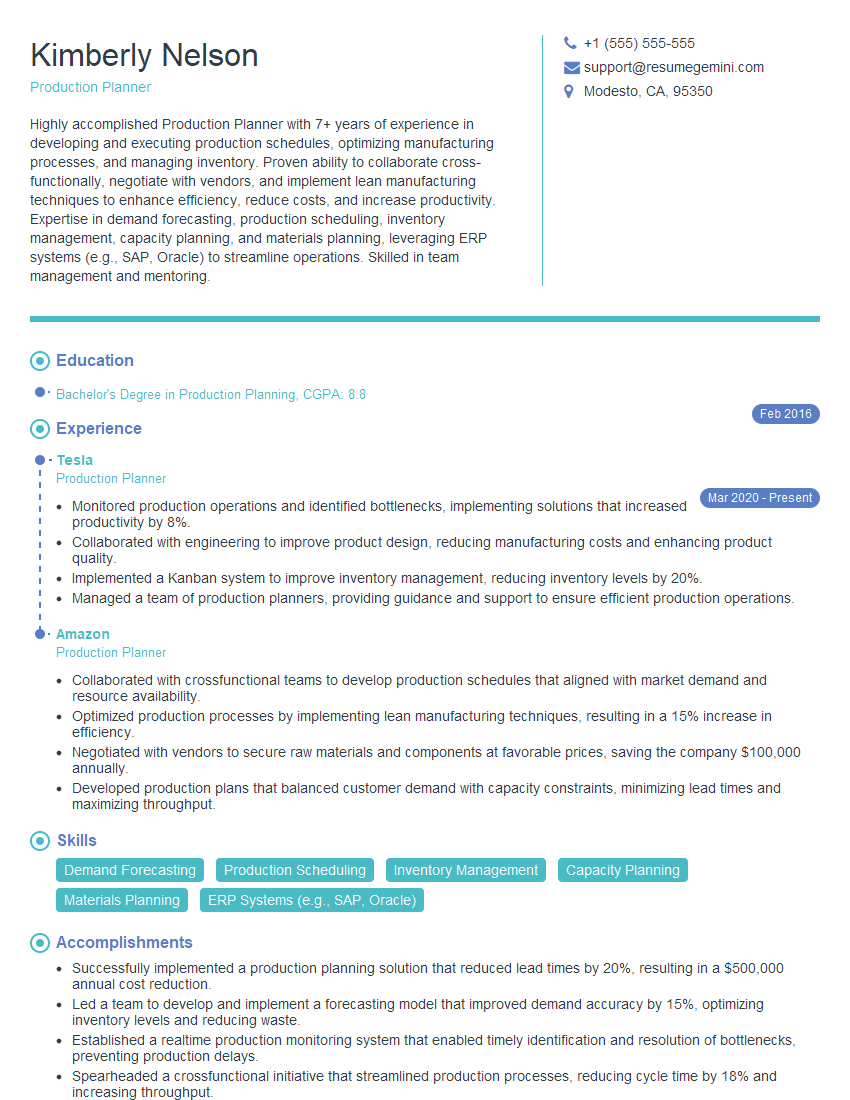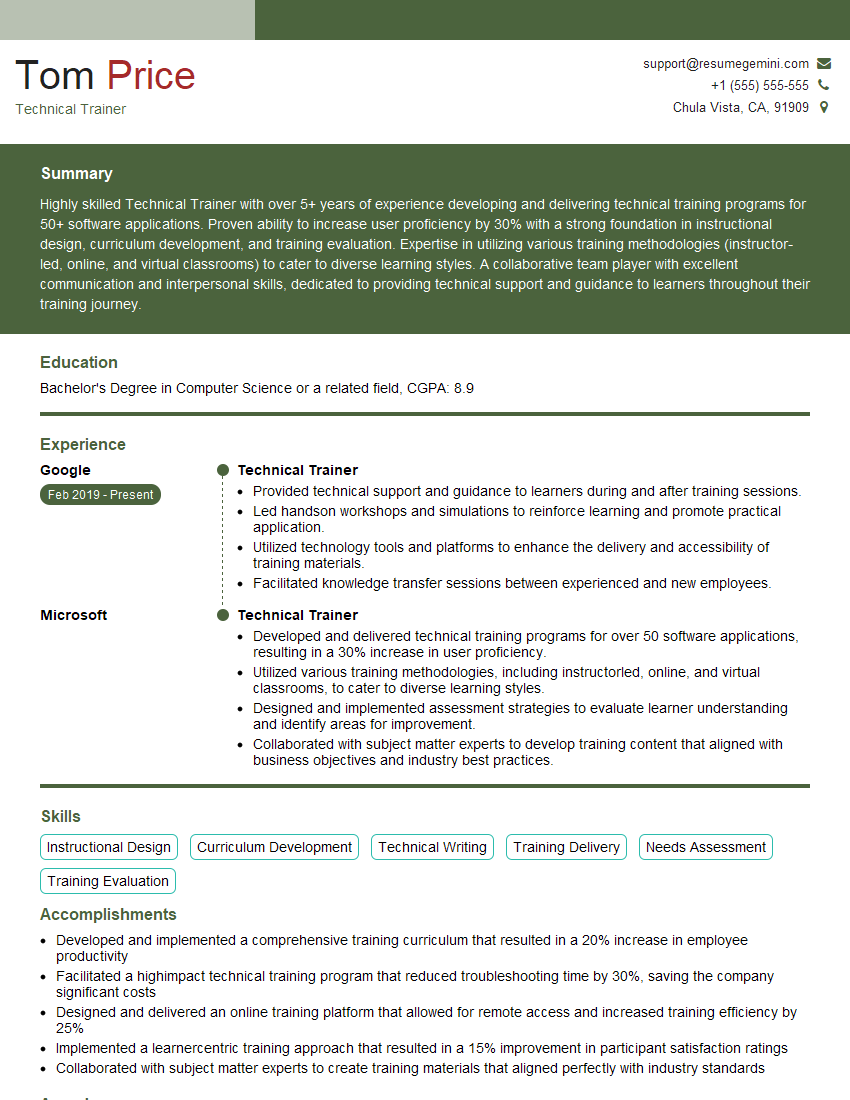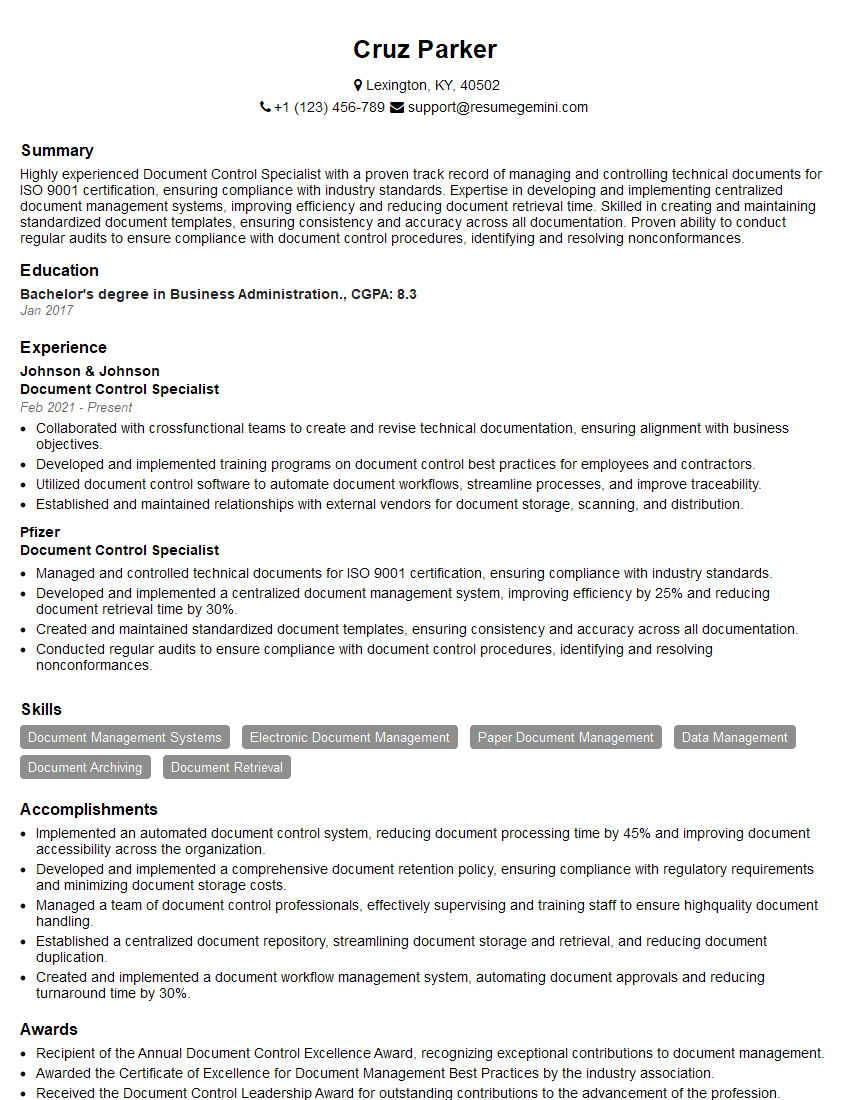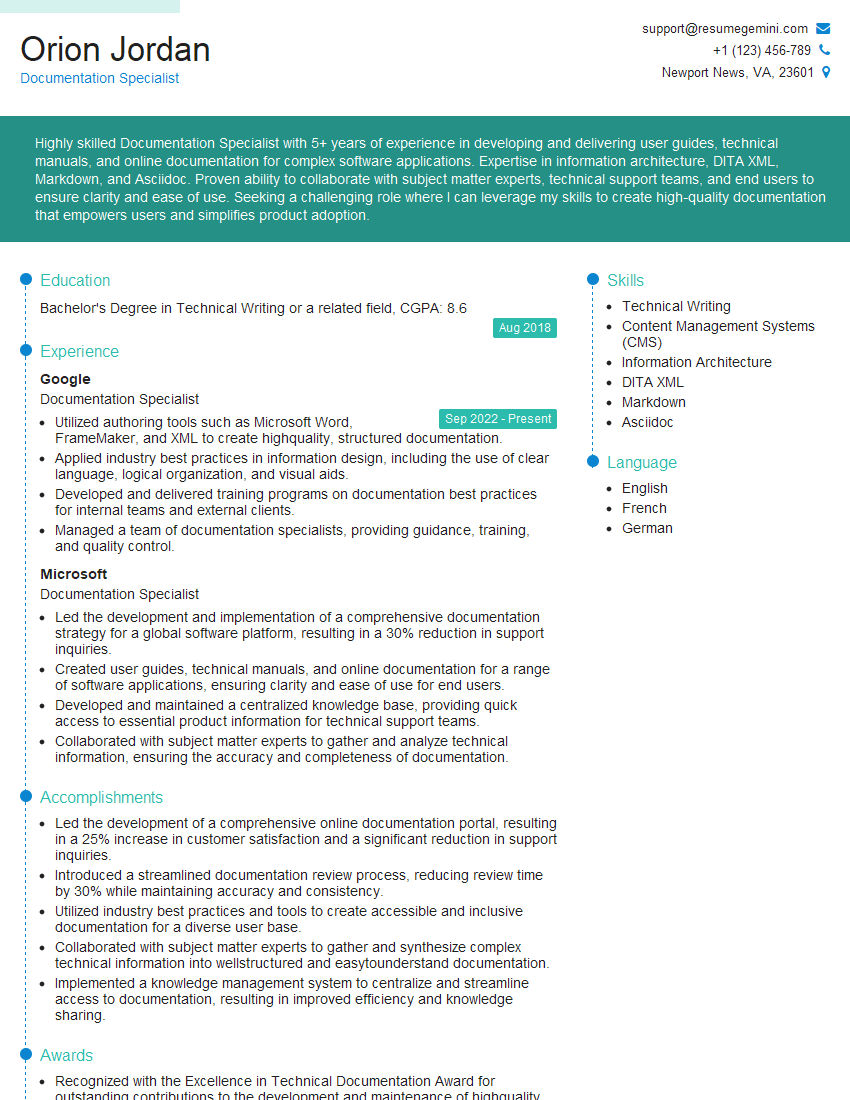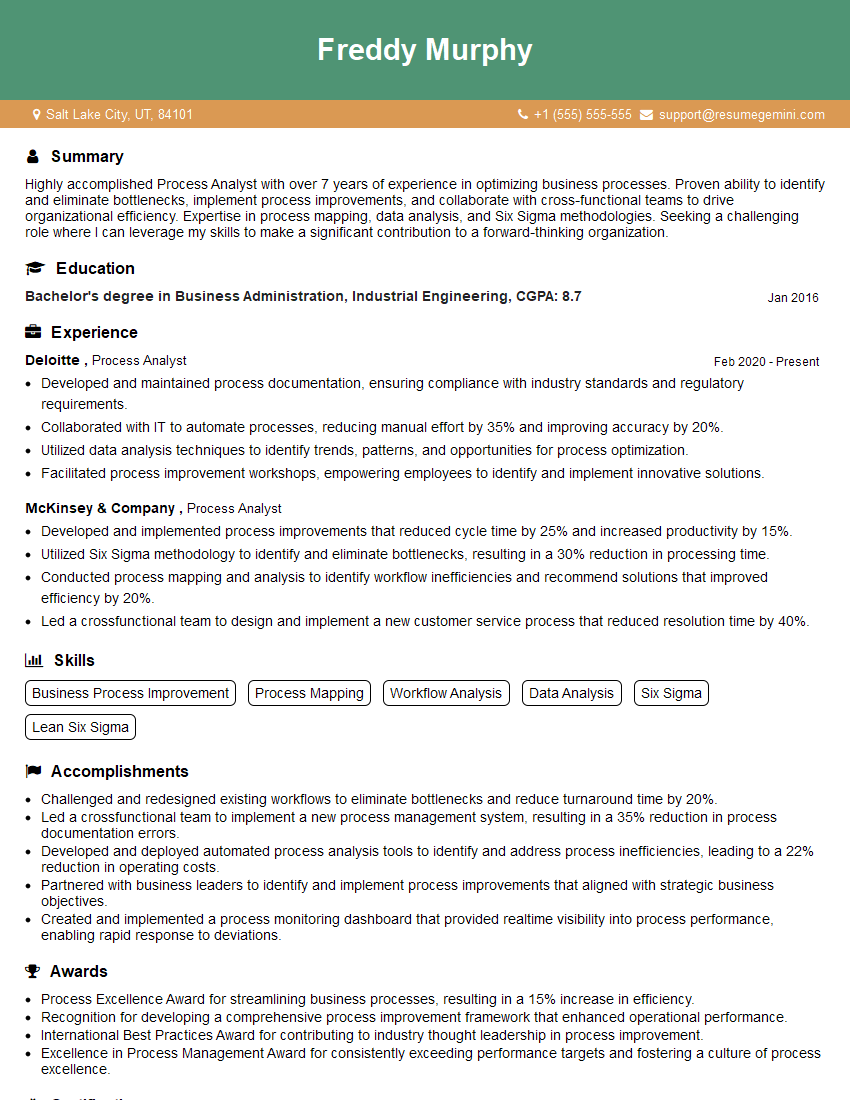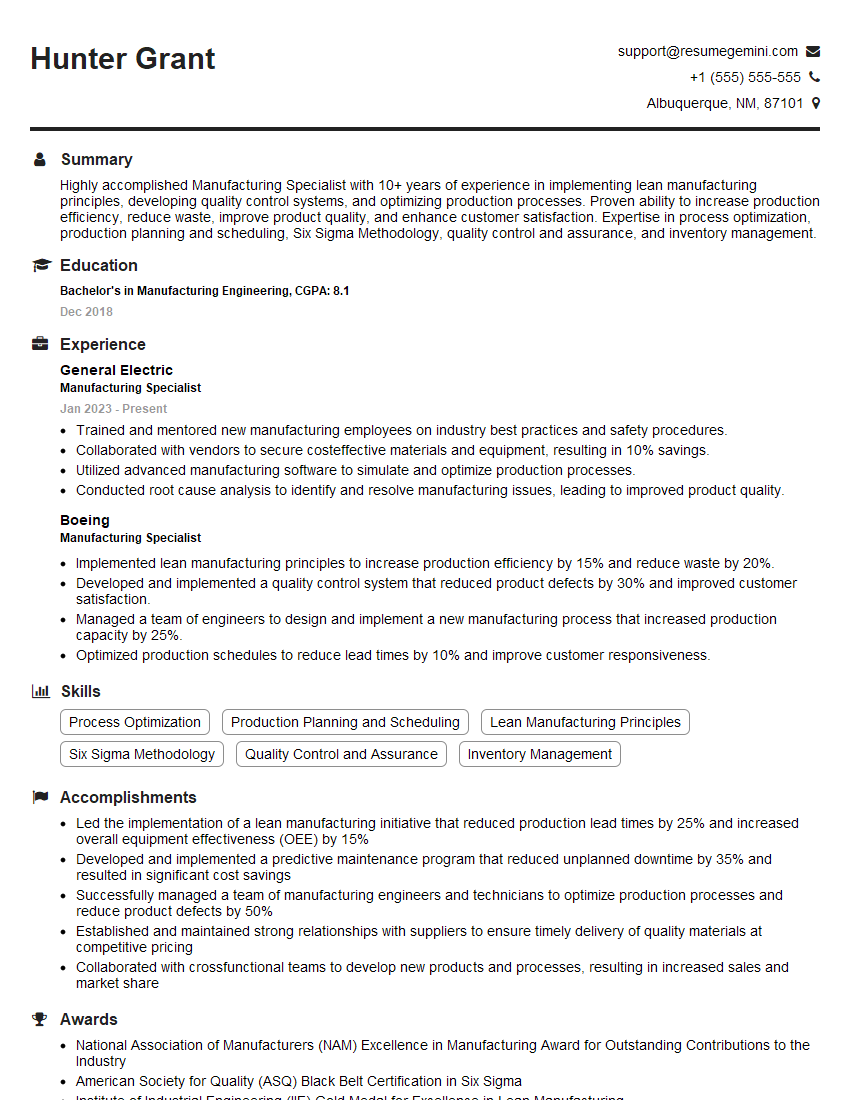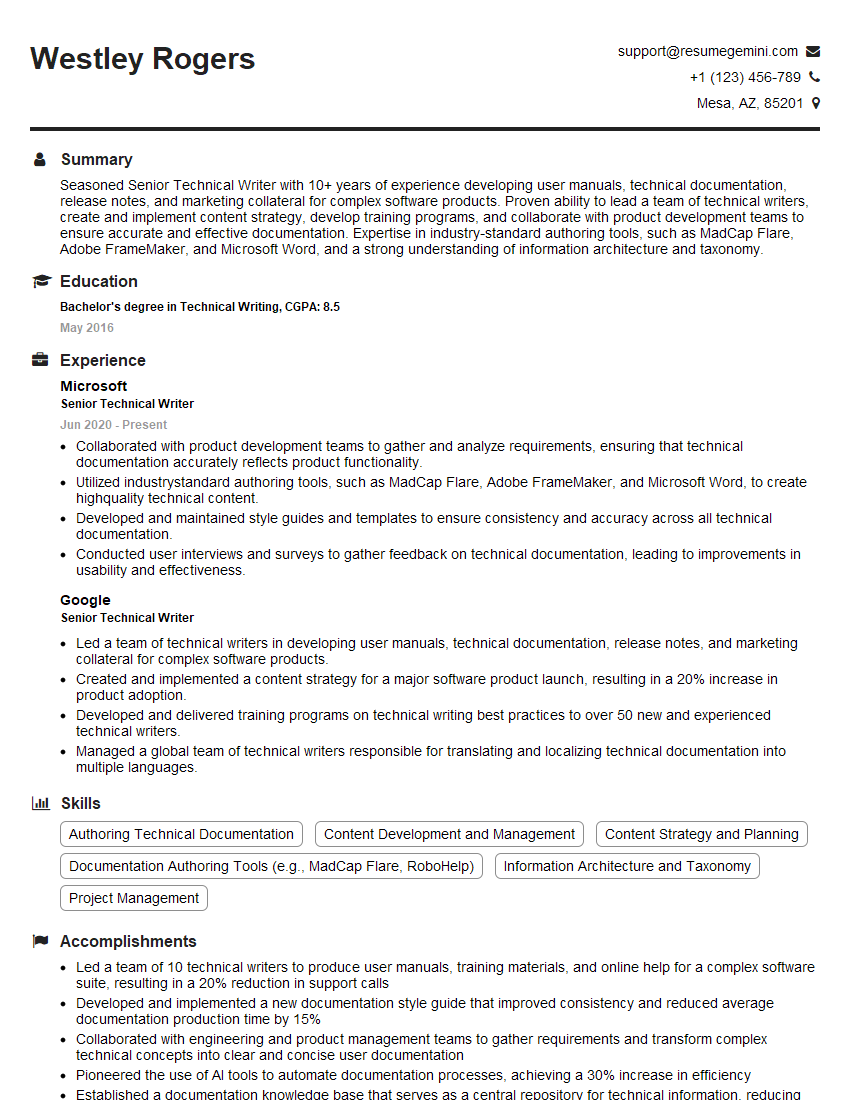Every successful interview starts with knowing what to expect. In this blog, we’ll take you through the top Collar Work Instructions Interpretation interview questions, breaking them down with expert tips to help you deliver impactful answers. Step into your next interview fully prepared and ready to succeed.
Questions Asked in Collar Work Instructions Interpretation Interview
Q 1. Explain the importance of clear and concise Collar Work Instructions.
Clear and concise Collar Work Instructions (CWIs) are paramount for safety, efficiency, and consistency in any operation involving collar work, such as wellhead maintenance or pipeline construction. Ambiguity can lead to errors, delays, and potentially catastrophic accidents. Think of CWIs as a recipe – if the instructions are unclear, the outcome is unpredictable. A well-written CWI leaves no room for misinterpretation, ensuring everyone involved understands the exact steps, precautions, and expected results.
- Safety: Precise language minimizes the risk of accidents caused by misunderstandings.
- Efficiency: Clear instructions streamline the workflow, reducing time spent on clarification and troubleshooting.
- Consistency: Standardized procedures ensure consistent quality and adherence to best practices across all operations.
Q 2. Describe your experience interpreting complex technical diagrams within Collar Work Instructions.
My experience interpreting complex technical diagrams in CWIs involves a methodical approach. I start by understanding the overall context of the diagram within the broader instructions. This includes carefully reviewing any accompanying text, legends, and annotations. Then, I systematically analyze the diagram itself, identifying key components, their relationships, and the sequence of operations depicted. For instance, in a diagram showing a wellhead assembly, I’d focus on identifying each valve, its function, and its connection to other components. I always verify the diagram’s version number and date to ensure I am working with the most up-to-date version. I’ve encountered diagrams using various formats, including isometric projections, cross-sections, and exploded views, each requiring a slightly different interpretive technique. I’m proficient in interpreting both 2D and 3D representations.
For example, I once worked on a CWI containing a complex piping and instrumentation diagram (P&ID) for a subsea wellhead. By carefully tracing the flow paths and pressure ratings indicated on the diagram, I was able to correctly identify the sequence of valve operations necessary for a safe isolation and intervention procedure.
Q 3. How do you identify and resolve ambiguities in Collar Work Instructions?
Ambiguities in CWIs are addressed through a multi-step process. First, I carefully reread the relevant section, looking for clues that might resolve the ambiguity. I also cross-reference the ambiguous instruction with other sections of the CWI, related documents, or engineering drawings. If the ambiguity persists, I escalate the issue to the appropriate engineering or supervisory personnel for clarification. Documentation of the ambiguity and its resolution is crucial for maintaining a clear record and preventing future issues. I’ve found that open communication and collaborative problem-solving are key to resolving ambiguities effectively. This often involves discussions with engineers, technicians, and operations personnel to ensure a shared understanding.
For instance, if a CWI states “tighten bolt X to specification,” but doesn’t specify the torque value, I would immediately consult the relevant engineering drawings or specifications to find the missing information. If I can’t find the information, I would escalate the issue to the relevant engineer to obtain clarification.
Q 4. How do you ensure Collar Work Instructions comply with relevant safety regulations?
Ensuring CWIs comply with safety regulations is a top priority. This involves a thorough review against relevant standards and legislation, such as OSHA regulations (in the US), or equivalent international standards. The review checks for compliance in areas like Personal Protective Equipment (PPE) requirements, permit-to-work procedures, lockout/tagout procedures, emergency response plans, and hazard identification and risk assessment. Any discrepancies must be addressed immediately. I also look for clear instructions on handling hazardous materials and potential environmental risks. Regular updates are crucial to keep CWIs current with evolving safety regulations and best practices.
For example, if a CWI describes a task involving high-pressure hydraulics without explicitly mentioning the use of appropriate pressure gauges and safety relief valves, I would identify this as a safety deficiency and recommend revisions to address the oversight.
Q 5. What methods do you use to verify the accuracy of Collar Work Instructions?
Verification of CWI accuracy is a multi-faceted process. It begins with a thorough technical review by subject matter experts to check for factual accuracy and completeness. This review might involve checking calculations, material specifications, and equipment compatibility. Next, I often conduct a desk check, reviewing the instructions for clarity, completeness, and logical flow. In some cases, a field verification may be necessary, whereby experienced personnel execute the instructions step-by-step in a controlled environment and provide feedback. This feedback helps identify potential issues that might not be apparent during a desk check. Finally, regular audits and reviews ensure CWIs stay current and relevant.
Q 6. Describe your experience in updating and revising Collar Work Instructions.
Updating and revising CWIs is a continuous process that requires a structured approach. It typically starts with identifying the need for a revision, perhaps due to equipment modifications, process improvements, or new safety regulations. The next step is to create a revision request, documenting the changes needed and their justifications. This is followed by the actual revision of the CWI, which involves careful editing to ensure clarity and consistency. Before the revised CWI is put into effect, a thorough review process must take place, often including peer reviews and approval from relevant stakeholders. Finally, the revised CWI is formally distributed and all previous versions are archived.
For example, if new equipment is installed, the relevant sections of the CWI describing the use of that equipment must be updated to reflect the changes in operating procedures and safety requirements.
Q 7. How do you handle conflicting information within different sections of Collar Work Instructions?
Conflicting information within a CWI is a serious issue requiring immediate attention. The first step is to carefully identify the conflicting statements and understand the source of the discrepancy. This usually involves cross-referencing information across different sections, diagrams, and supporting documentation. Then, I attempt to resolve the conflict through careful analysis, often by identifying the most authoritative source of information. If the conflict cannot be easily resolved, I escalate the issue to the relevant engineering or management personnel for a definitive resolution. Documentation is crucial in such cases, preserving a record of the conflict, the investigation, and the final resolution to ensure consistency and prevent recurrence.
For example, if one section of the CWI specifies a specific pressure setting for a valve, while another section implies a different setting, I would investigate to find the correct setting, perhaps by consulting the original design specifications or talking to the equipment vendor.
Q 8. Explain your process for identifying potential hazards described in Collar Work Instructions.
Identifying potential hazards in Collar Work Instructions (CWIs) requires a systematic approach. I begin by thoroughly reviewing each step outlined in the instructions, looking for anything that could potentially lead to injury, damage, or inefficiency. This includes considering the tools and equipment used, the work environment, and the potential for human error.
My process involves a hazard identification matrix where I list each step, the potential hazards associated with that step, and the severity and likelihood of those hazards. For example, if the CWI describes using a specific chemical, I’d note the potential for chemical burns or inhalation hazards. If the instructions involve working at heights, I’d identify the risk of falls. Following the hazard identification, I then analyze control measures already in place and recommend additional precautions if needed. This might involve adding personal protective equipment (PPE) requirements, specifying safe work practices, or outlining emergency procedures.
- Step 1: Detailed review of each step in the CWI.
- Step 2: Hazard identification using a matrix (step, hazard, severity, likelihood).
- Step 3: Assessment of existing control measures.
- Step 4: Recommendation of additional precautions or improvements.
Q 9. How do you ensure the instructions are understandable by workers with varying skill levels?
Ensuring CWIs are understandable across skill levels requires a multi-faceted approach. I avoid jargon and technical terms wherever possible, opting for clear, concise language. Visual aids are crucial – diagrams, flowcharts, and even short videos can greatly enhance comprehension. I use a layered approach, providing a high-level overview for less experienced workers and more detailed information for skilled workers. For example, simple instructions might focus on the overall process, while more detailed instructions might include troubleshooting steps and advanced techniques.
I also incorporate various learning styles by utilizing different methods. For instance, visual learners benefit from diagrams and videos, while kinesthetic learners might need hands-on training alongside the CWIs. Regular feedback sessions and assessments help me fine-tune the clarity and effectiveness of the instructions. Finally, using multiple languages or translating the instructions into different languages, if applicable, can greatly increase comprehension for workers from diverse backgrounds.
Q 10. How do you incorporate feedback from workers to improve Collar Work Instructions?
Worker feedback is invaluable for improving CWIs. I actively solicit feedback through various channels, including regular meetings, surveys, and informal discussions. I encourage workers to share their experiences, identifying areas where the instructions are unclear, inefficient, or unsafe.
I treat every piece of feedback seriously, analyzing trends and patterns to pinpoint recurring issues. For example, if multiple workers mention difficulty understanding a specific step, I’ll revise that section to improve clarity. If safety concerns are raised, I’ll prioritize addressing those concerns. This might involve revising the steps, adding safety precautions, or providing additional training. The feedback loop helps ensure the CWIs are practical, relevant, and worker-centric.
Q 11. Describe your experience with different formats for Collar Work Instructions (e.g., text, diagrams, videos).
I’ve worked with various formats for CWIs, each with its strengths and weaknesses. Text-based instructions are straightforward but can be cumbersome for complex tasks. Diagrams are excellent for visualizing steps and equipment, but they might not convey the nuances of the process. Videos are effective for demonstrating techniques and showcasing best practices. Ideally, a combination of formats works best. For instance, a video demonstration can be supplemented with text-based instructions for reference and a checklist for verification.
I’ve found that interactive digital manuals offer the most flexibility, allowing for multimedia integration, updates, and tracking of worker progress. However, the format chosen always depends on the specific task and the audience. For example, a simple task might only require a text-based checklist, whereas a complex assembly process might require a detailed video tutorial along with step-by-step diagrams and text instructions.
Q 12. How do you ensure Collar Work Instructions are consistently applied across different teams?
Consistent application of CWIs across different teams requires a structured approach. First, I ensure that all teams receive the same, updated version of the instructions. This often involves using a centralized system for document management and version control. Regular training sessions and refresher courses help ensure everyone understands and applies the instructions correctly.
Secondly, I establish a clear communication channel for addressing any inconsistencies or questions that may arise across teams. This might involve team leaders providing regular feedback, or establishing a dedicated communication channel for reporting any deviations from the established procedures. Finally, using clear and consistent terminology throughout the instructions minimizes potential for misinterpretations across teams.
Q 13. What software or tools are you familiar with for creating and managing Collar Work Instructions?
I’m familiar with several software and tools for creating and managing CWIs. These include document management systems like SharePoint and Google Workspace, which facilitate version control and collaborative editing. I’ve also used dedicated instructional design software that allows for multimedia integration and interactive elements. For video-based instructions, I’m proficient in using video editing software such as Adobe Premiere Pro or DaVinci Resolve. Additionally, I utilize project management tools like Asana or Trello for tracking the creation, review, and deployment of CWIs.
Q 14. Describe a time you had to troubleshoot a problem using only Collar Work Instructions.
During a recent project, a critical component malfunctioned mid-process. The CWIs were detailed, but the specific error wasn’t directly addressed. However, the instructions did include comprehensive troubleshooting steps and a flowchart for diagnosing problems. I systematically followed the flowchart, checking the system’s various components based on the error messages.
Step-by-step troubleshooting using the CWI:
1. Identified the error code displayed on the component.
2. Consulted the flowchart in the CWI to locate the troubleshooting section for that error code.
3. Followed the instructions to check each suggested component, starting with the most likely cause.
4. Detected a loose connection, a detail not explicitly mentioned in the initial instructions, but covered within the troubleshooting section.
5. Fixed the loose connection and verified the proper functioning of the component.
This experience highlighted the importance of detailed troubleshooting guides within CWIs. It also emphasized that even though a specific problem might not be explicitly detailed, well-structured instructions can still guide you to a solution.
Q 15. How do you manage changes and updates to existing Collar Work Instructions?
Managing changes to Collar Work Instructions (CWIs) requires a robust system that balances efficiency with accuracy. We use a formal change management process, typically involving a request form detailing the proposed alteration, its rationale, and potential impact. This request is then reviewed by a team including subject matter experts, process engineers, and representatives from affected departments. After approval, the CWI is updated, a new version is created (see below on version control), and the update is communicated effectively to all relevant personnel. We also maintain a change log, meticulously tracking all modifications, the date of implementation, and the author responsible. This ensures traceability and accountability.
For example, if a new piece of equipment is introduced impacting a specific collar operation, a change request is raised, the process is revised, and new images/diagrams are included in the updated CWI. The impact assessment might involve confirming compatibility with existing safety procedures.
Career Expert Tips:
- Ace those interviews! Prepare effectively by reviewing the Top 50 Most Common Interview Questions on ResumeGemini.
- Navigate your job search with confidence! Explore a wide range of Career Tips on ResumeGemini. Learn about common challenges and recommendations to overcome them.
- Craft the perfect resume! Master the Art of Resume Writing with ResumeGemini’s guide. Showcase your unique qualifications and achievements effectively.
- Don’t miss out on holiday savings! Build your dream resume with ResumeGemini’s ATS optimized templates.
Q 16. Explain your understanding of version control in the context of Collar Work Instructions.
Version control for CWIs is crucial for maintaining accuracy and avoiding confusion. We utilize a system – often a dedicated document management system – that assigns a unique version number to each iteration (e.g., CWI-1234-v1, CWI-1234-v2). This allows us to easily track changes, revert to previous versions if necessary, and ensure everyone is working from the most current and approved version. Each version is clearly timestamped and indicates the nature of the changes made. This approach prevents accidental use of outdated instructions, reducing errors and improving overall efficiency and safety.
Imagine a scenario where a minor correction was made in version v2. The version control system allows us to easily identify this correction, ensuring that training materials and on-the-floor procedures are consistent and accurate. Furthermore, it permits a simple audit trail for any investigation into issues.
Q 17. How do you ensure the instructions are easily searchable and accessible to workers?
Accessibility and searchability of CWIs are paramount. We employ a combination of strategies to achieve this. Firstly, all CWIs are stored in a centralized, easily accessible digital repository, often integrated with our company’s intranet. Secondly, we use a robust keyword tagging system to improve searchability. For example, a CWI related to ‘collar stitching’ would be tagged with relevant keywords like ‘stitching’, ‘collar’, ‘sewing’, ‘machine type’, and other specific terms relevant to its content. The repository itself should have a powerful search function enabling quick and relevant results. Finally, visual aids and clear, concise language are used to ensure the instructions are easily understood even without a deep search. We even consider color-coding elements to expedite visual identification of key steps or warnings.
In addition, regular internal communication emphasizes the repository’s usability and encourages workers to leverage it. We also provide training on how to effectively use the search functionality.
Q 18. Describe your experience in collaborating with other teams to develop Collar Work Instructions.
Collaboration is vital in developing CWIs. I routinely work with teams including engineering (for equipment specifications), production (for practical insights), safety (for hazard identification), and quality control (for accuracy and compliance). We utilize collaborative software platforms that allow for real-time editing, comment threads, and version history tracking, fostering a transparent and efficient process. Regular meetings, both virtual and in-person, are held to discuss progress, address concerns, and ensure alignment on the final product. This multi-disciplinary approach ensures that CWIs are comprehensive, practical, and reflect the perspectives of everyone involved.
For instance, when developing CWIs for a new automated collar-attaching machine, close collaboration with the engineering team was crucial to accurately describe the machine’s operation, safety features, and potential hazards.
Q 19. How do you ensure the Collar Work Instructions remain up-to-date with technological advancements?
Keeping CWIs updated with technological advancements is a continuous process. We establish a system for reviewing CWIs regularly, typically annually or whenever significant technological changes affect the collar production process. This review includes assessing the impact of new equipment, software, or techniques on existing instructions. The review process should identify any outdated information, obsolete methods, and areas for improvement. New or revised CWIs are then created, going through the standard change management process mentioned previously. Regular training sessions are also critical in incorporating new technologies into the workflow and ensuring workers are comfortable and proficient with updated procedures.
For example, the introduction of new, faster sewing machines might require updating CWIs with new speed settings and safety guidelines.
Q 20. What are the key elements of effective Collar Work Instructions?
Effective CWIs are characterized by several key elements. They should be:
- Clear and concise: Using simple language and avoiding jargon.
- Step-by-step instructions: Breaking down complex tasks into easily manageable steps.
- Visually appealing: Utilizing diagrams, images, and flowcharts to aid understanding.
- Accurate and up-to-date: Reflecting the current processes and equipment.
- Safe: Highlighting potential hazards and safety precautions.
- Accessible: Easy to find, read, and understand by all workers.
- Consistent: Using a consistent format and terminology throughout.
The overall goal is to create a document that is easily understood, followed, and referenced. This promotes efficiency, safety, and quality in the collar production process.
Q 21. How do you incorporate best practices for usability into Collar Work Instructions?
Usability is paramount. We incorporate best practices by:
- Using clear and simple language: Avoiding technical jargon and using plain English.
- Employing visual aids: Including diagrams, illustrations, and photos to illustrate each step.
- Structuring information logically: Using headings, subheadings, and bullet points to organize content.
- Providing clear and concise step-by-step instructions: Breaking down the process into small, manageable tasks.
- Using a consistent format and layout: Ensuring that all CWIs follow the same style guide.
- Conducting usability testing: Having potential users review the CWIs before they are implemented to identify any areas for improvement.
Usability testing is particularly valuable, as it allows us to gather feedback and make adjustments based on real-world usage. This iterative approach ensures the CWIs are truly user-friendly and efficient.
Q 22. How do you assess the effectiveness of Collar Work Instructions?
Assessing the effectiveness of Collar Work Instructions (CWIs) involves a multi-faceted approach focusing on clarity, accuracy, completeness, and worker feedback. It’s not just about whether the instructions are *written*, but whether they’re *understood and followed correctly*.
- Observation: Directly observe workers performing tasks guided by the CWIs. Note any hesitations, errors, or deviations from the instructions. This provides firsthand evidence of where the instructions fall short.
- Data Analysis: Track key metrics like error rates, production output, and time-to-completion for tasks. A higher-than-acceptable error rate or significant time delays could indicate poorly written or inadequate CWIs.
- Worker Feedback: Regularly solicit feedback from workers using surveys, interviews, or informal discussions. Their practical experience provides invaluable insights into areas for improvement. This might involve asking about clarity, comprehensibility, or any missing steps.
- Regular Reviews: Conduct periodic reviews of CWIs, ideally incorporating data analysis and worker feedback. Outdated processes, changes in materials, or technological advancements often necessitate updates.
For example, if we observe consistent errors in a specific step of collar assembly, leading to significant rework and decreased production efficiency, it’s a clear sign the corresponding CWI needs immediate revision.
Q 23. Describe a time you identified an error or omission in Collar Work Instructions.
During a CWI review for a new collar design, I noticed a crucial omission in the instructions for attaching the lining. The instructions correctly described the steps for attaching the outer fabric but failed to mention the necessary pre-treatment of the lining fabric with a specific adhesive. This omission could have led to poor adhesion, resulting in a faulty product and potential customer dissatisfaction.
I immediately flagged this issue and worked with the design and manufacturing teams to incorporate the missing step into the CWIs. We then implemented a training session for all affected workers to ensure they understood the revised procedure. This proactive approach prevented potential production delays and quality issues.
Q 24. How do you communicate changes in Collar Work Instructions to affected workers?
Communicating changes in CWIs requires a structured and multi-pronged strategy to ensure all affected workers receive the information and understand its implications.
- Formal Announcement: Issue a formal announcement through email or a company-wide communication system. This announcement should clearly state the nature of the changes, their effective date, and the reasons for the update.
- Updated Documents: Make the revised CWIs readily available in a central, easily accessible location (e.g., an intranet or shared drive). Version control is crucial to avoid confusion.
- Training and Workshops: Conduct training sessions or workshops to walk workers through the changes. This hands-on approach ensures everyone fully understands the updated procedures and has the opportunity to ask questions.
- Individual Follow-Up: For particularly complex or critical changes, consider conducting one-on-one follow-ups with individual workers, especially those who may struggle with the updates.
- Visual Aids: Include visual aids such as diagrams, flowcharts, or videos in the updated CWIs to enhance understanding, particularly if the changes involve complex steps or adjustments.
For instance, if a change involves a new tool or technique, a short video demonstration would be incredibly helpful in ensuring consistent implementation.
Q 25. What are the potential consequences of unclear or inaccurate Collar Work Instructions?
Unclear or inaccurate CWIs can have serious consequences, impacting various aspects of the business, including quality, safety, and efficiency.
- Product Defects: Inaccurate instructions can lead to production of faulty products, resulting in increased rework, waste, and potentially customer complaints or returns.
- Safety Hazards: Incomplete or unclear instructions on safety procedures can pose significant risks to workers, leading to injuries or accidents.
- Production Delays: Workers struggling with unclear instructions will naturally experience delays, affecting production schedules and potentially jeopardizing deadlines.
- Increased Costs: Rework, waste, and potential legal ramifications stemming from safety incidents all contribute to significant increases in production costs.
- Reputational Damage: Consistent quality issues linked to poor CWIs can damage a company’s reputation and erode customer trust.
Imagine a situation where unclear instructions about handling a specific chemical result in a worker injury. The consequences—from medical expenses and legal fees to the damage to the company’s reputation—can be devastating.
Q 26. How do you prioritize different tasks when updating or revising Collar Work Instructions?
Prioritizing tasks when updating or revising CWIs requires a risk-based approach. We need to focus first on those changes that present the greatest potential negative impact.
- High-Risk/High-Impact: This includes any updates addressing safety concerns, those that prevent potential production of faulty products, or updates related to critical processes. These issues should be tackled first.
- High-Frequency Tasks: Instructions for frequently performed tasks should be prioritized as even small inaccuracies can lead to significant cumulative errors and inefficiencies.
- Worker Feedback: Updates identified through significant worker feedback should also be prioritized, as they represent areas where the current CWIs are clearly causing problems.
- Regulatory Compliance: Updates needed to maintain regulatory compliance must always take precedence.
Using a simple risk matrix that considers likelihood and impact can help visualize and prioritize these updates.
Q 27. How do you handle situations where Collar Work Instructions are incomplete or outdated?
Handling incomplete or outdated CWIs requires immediate action to prevent potential issues. The steps involved are similar to those described above when updating existing documents.
- Gap Analysis: Identify the specific gaps or outdated information within the CWIs. Determine what information is missing, inaccurate, or no longer relevant.
- Subject Matter Expert Consultation: Engage subject matter experts (SMEs) to gather the necessary information to complete or update the CWIs. This often requires collaboration with design, engineering, and manufacturing teams.
- Verification and Validation: Once updated, the revised CWIs must be thoroughly reviewed and validated to ensure accuracy, completeness, and clarity. This might involve trials or pilot testing before widespread implementation.
- Communication and Training: Just like any other change, communicate the updates to all affected workers and provide any necessary training.
Failing to address incomplete or outdated CWIs creates a recipe for disaster. Imagine trying to assemble a collar without a complete set of instructions; the results are likely to be frustrating and potentially costly.
Key Topics to Learn for Collar Work Instructions Interpretation Interview
- Understanding Work Instruction Formats: Familiarize yourself with various formats used for collar work instructions, including visual aids, flowcharts, and textual descriptions. Practice interpreting instructions presented in different styles.
- Identifying Key Information: Develop skills in quickly identifying critical information within complex instructions, such as safety procedures, sequence of operations, and quality control checkpoints. Practice extracting relevant details from lengthy or ambiguous instructions.
- Applying Instructions to Practical Scenarios: Practice applying your interpretation skills to simulated work scenarios. Focus on visualizing the steps involved and anticipating potential challenges or deviations from the standard procedure.
- Problem-Solving & Troubleshooting: Learn to identify and address discrepancies or ambiguities within collar work instructions. Develop strategies for resolving inconsistencies and escalating issues appropriately.
- Safety Procedures & Compliance: Thoroughly understand and be able to explain the importance of adhering to all safety protocols outlined in the collar work instructions. Practice recognizing potential safety hazards and mitigation strategies.
- Documentation & Record Keeping: Understand the importance of accurate documentation and record keeping related to following collar work instructions. This includes documenting any deviations or problems encountered.
- Technical Terminology & Jargon: Become comfortable with industry-specific terminology and jargon commonly found in collar work instructions. Build your vocabulary to ensure complete comprehension.
Next Steps
Mastering Collar Work Instructions Interpretation is crucial for career advancement in many technical fields. It demonstrates attention to detail, problem-solving abilities, and a commitment to safety and compliance. To maximize your job prospects, create an ATS-friendly resume that clearly highlights your skills and experience in interpreting and applying work instructions. ResumeGemini is a trusted resource that can help you build a compelling and effective resume. Examples of resumes tailored to Collar Work Instructions Interpretation are available to guide you. Invest in your future – craft a resume that showcases your expertise and lands you your dream job!
Explore more articles
Users Rating of Our Blogs
Share Your Experience
We value your feedback! Please rate our content and share your thoughts (optional).
What Readers Say About Our Blog
Hello,
We found issues with your domain’s email setup that may be sending your messages to spam or blocking them completely. InboxShield Mini shows you how to fix it in minutes — no tech skills required.
Scan your domain now for details: https://inboxshield-mini.com/
— Adam @ InboxShield Mini
Reply STOP to unsubscribe
Hi, are you owner of interviewgemini.com? What if I told you I could help you find extra time in your schedule, reconnect with leads you didn’t even realize you missed, and bring in more “I want to work with you” conversations, without increasing your ad spend or hiring a full-time employee?
All with a flexible, budget-friendly service that could easily pay for itself. Sounds good?
Would it be nice to jump on a quick 10-minute call so I can show you exactly how we make this work?
Best,
Hapei
Marketing Director
Hey, I know you’re the owner of interviewgemini.com. I’ll be quick.
Fundraising for your business is tough and time-consuming. We make it easier by guaranteeing two private investor meetings each month, for six months. No demos, no pitch events – just direct introductions to active investors matched to your startup.
If youR17;re raising, this could help you build real momentum. Want me to send more info?
Hi, I represent an SEO company that specialises in getting you AI citations and higher rankings on Google. I’d like to offer you a 100% free SEO audit for your website. Would you be interested?
Hi, I represent an SEO company that specialises in getting you AI citations and higher rankings on Google. I’d like to offer you a 100% free SEO audit for your website. Would you be interested?
good


